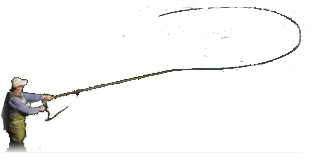-
Info needed
With this forum having international aspects these days I need some info.
When tiers from the U.K. say their fly patterns (recipes) are based on North Country Spiders are they really saying that all those flies are to represent spiders or is it a local generic term?
-
Just another term for what we refer to as soft hackle type flies.
-
They most definitely were not tied to represent spiders.
But I'm not sure where the term "spider" came from or why it was used. Maybe it's a Scottish term.
-
Ray,
I am sure I will be corrected, which is fine, but North Country Spiders, I believe, refers to the original soft hackle flies or spiders tied by the Scottish tyers, Scotland being the north country.
Larry ---sagefisher---
-
Larry,
I am pretty sure the "North Country" is the area of England south of Scotland............
-
Interesting question. OED cites William Stewart's Practical Angler (1857) as a source, and Stewart stated: "The artificial flies in common use may be divided into two classes. There is first the winged fly, which alone, properly speaking, merits the appellation; and there is the palmer hackle or spider, by which last name we mean to call it, believing that if it resembles anything in the insect tribe, it is a spider." While this might imply a more inclusive meaning than we use today, he goes on to clarify that: "We, however, think the hackle by no means deserving of so much attention as is bestowed upon it, being too stiff and wiry to represent the legs of an insect, and we prefer hen hackles, or still better, the small feathers taken from the neck, or outside of the wings of a variety of small birds...Amongst those most serviceable to the angler are the small feathers taken from the outside of the wings, as also from the neck and shoulders of the following birds : The starling, landrail, dotterel, mavis, grey plover, golden plover, partridge, and grouse."
So yes, they are just talking about soft-hackles, historically, if my reading is correct. One wonders whether or not "spider" was also used in the 19th century as a generic term. T.E. Pritt in North Country Flies refers to his Water Cricket as imitating an insect in a particular stage where it "...not a fly, but an active little spider." Hopefully someone with an better understanding of the literature and 19th century angling will chime in with a more precise answer.
-
Whatfly,
Good response. I believe the term simply refers to an emerging insect.
-
Print himself said. "It is far more difficult to imitate a perfect insect and to afterwards impart to it a semblance of life in or on the water, than it is to produce something which is sufficiently near a resemblance OF AN IMPERFECTLY DEVELOPED INSECT, STRUGGLING TO ATTAIN THE SURFACE OF THE STREAM."
Emphasis added........an emerging insect, I.e., an emerging fly.
-
Thanks guys. I suspected that this was the case.
-
If you read through the texts, I think originally "spider' meant a small struggling "spider" as stated. It since evolved into what we refer to as a soft hackle and accepted as representing a large number of emerging insects.
